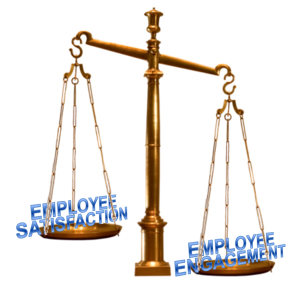 Time for me to get up on the soapbox again.
Time for me to get up on the soapbox again.
I recently came across a survey conducted by SilkRoad, a “leading provider of cloud-based, social talent management solutions.” In other words, they do the human resources thing.
Their survey polled nearly 800 HR professionals on a number of issues related to engaging and energizing employees for business success. As someone who constantly stresses the importance of developing an engaged and inspired workforce, I would like to say that I found the results pleasantly surprising. Unfortunately, I can’t.
According to the survey, 54% said their company did not have an explicit employee engagement program. Thirty-eight percent said they did have such programs. The remaining 7% did not know. Many of the 54% reported having some informal employee engagement efforts in their companies. Nevertheless, the results indicate that, for the majority of companies, senior management has still not made employee engagement a strategic priority.
People – wake up and smell the coffee!
Employee engagement is not some “soft” topic that you discuss once a year in a management seminar and then dismiss entirely until the seminar rolls around again. It’s an essential component for developing strategically agile organizations that can survive and thrive in today’s hyper-paced markets. These days, everyone has access to the same information and technologies. The difference is having an engaged and committed workforce that can put them to good use and turn market laggers into market leaders.
What happens when you don’t have an engaged workforce? Again, no surprises from the survey:
- Low morale – 67%
- Unmotivated employees – 66%
- Employees who feel unappreciated – 64%
- Inability to retain employees – 48%
Other reported impacts included increased absenteeism and poor relationships between employees and customers – not exactly the kind of workforce that’s going to give you an edge when competing in crowded markets.
And guess what? Money does not work well as a tool of engagement!
According to the HR professionals in the survey, the two least effective employee engagement tools were diversified compensation options (5%) and good pension and retirement plans (4%). Salary and good benefits came in slightly ahead of these two categories. But they still lagged far behind other engagement mechanisms.
What does work?
The top two ways to foster employee engagement were trust in management (56%) and career development (52%). These were followed by stimulating work environment, recognition and rewards, flexible work options (i.e., work from home), learning opportunities, and career advancement.
Getting employees engaged isn’t rocket science. So why doesn’t it happen in more organizations? I see two primary reasons.
One, we’re all running so fast just to keep up that taking the time to focus on employee engagement seems like it will slow us down rather than help reach the destination. Two, despite countless studies showing the value of employee engagement, we still have all kinds of thought bubbles that get in the way. For example:
- We don’t have time for employee engagement.
- I’m not good at that touchy-feely stuff.
- We don’t need people to feel engaged; we just need them to do their jobs.
- Employees should motivate themselves.
- In today’s economy people should be grateful just to have a job.
As for the part about employee engagement slowing us down, nothing could be farther from the truth.
Granted, it takes time to develop and implement recognition programs, provide learning opportunities, and create a culture of accountability. But if we don’t do these things, we end up with unmotivated employees who care more about collecting a paycheck than doing things right. When we don’t do things right the first time, we get to do them again and again (if our markets let us). Meanwhile, competitors who get it right the first time are leaving us in the dust.
One final key point from the survey – employee engagement can’t be approached as a quick fix or “flavor of the month” management fad. Rather, it needs to become an integral part of the company’s values and operating processes. To quote from the Silkroad survey report:
“Engagement is a strategy that should ripple through the organization – leadership should not regard it as a checklist item. Companies must begin to think strategically and plan deliberately for engagement.”
I’m a big believer in making decisions based on data rather than thought bubbles. And the data shows it again and again – employee engagement has a measurable impact on the bottom line. Isn’t it about time we started paying attention?
Call to action: Commit to taking one action today that will encourage employee engagement.






